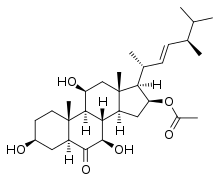 | |
| Clinical data | |
|---|---|
| Other names | NGA0187; NGD-187; 16β-Acetoxy-3β,7β,11β-trihydroxy-5α-ergost-22E-en-6-one |
| Identifiers | |
| |
| CAS Number | |
| PubChem CID | |
| ChemSpider | |
| ChEMBL | |
| Chemical and physical data | |
| Formula | C30H48O6 |
| Molar mass | 504.708 g·mol−1 |
| 3D model (JSmol) | |
| |
| |
Anicequol (developmental code names NGA0187, NGD-187)[1] is a naturally occurring ergostane steroid produced by Acremonium sp. TF-0356 which has nerve growth factor-like neurotrophic activity.[2][3][4] It was under investigation by Taisho Pharmaceutical in Japan for the treatment of cognitive disorders in the 1990s, but development was discontinued and the drug was never marketed.[5]
Chemistry
See also
References
- ↑ Gao SS, Li XM, Li CS, Proksch P, Wang BG (2011). "Penicisteroids A and B, antifungal and cytotoxic polyoxygenated steroids from the marine alga-derived endophytic fungus Penicillium chrysogenum QEN-24S". Bioorg. Med. Chem. Lett. 21 (10): 2894–7. doi:10.1016/j.bmcl.2011.03.076. PMID 21489788.
Anicequol (3) was independently isolated from Acremonium sp. TF-0356 and was assigned the trivial name NGA0187.
- ↑ Nozawa Y, Sakai N, Matsumoto K, Mizoue K (2002). "A novel neuritogenic compound, NGA0187". J. Antibiot. 55 (7): 629–34. doi:10.7164/antibiotics.55.629. PMID 12243452.
- ↑ Hua Z, Carcache DA, Tian Y, Li YM, Danishefsky SJ (2005). "The synthesis and preliminary biological evaluation of a novel steroid with neurotrophic activity: NGA0187". J. Org. Chem. 70 (24): 9849–56. doi:10.1021/jo051556d. PMID 16292815.
- ↑ Williams B, Dwyer DS (2009). "Structure-based discovery of low molecular weight compounds that stimulate neurite outgrowth and substitute for nerve growth factor". J. Neurochem. 110 (6): 1876–84. doi:10.1111/j.1471-4159.2009.06291.x. PMC 2753211. PMID 19627449.
- ↑ "NGD 187 - AdisInsight". adisinsight.springer.com.
External links
This article is issued from Wikipedia. The text is licensed under Creative Commons - Attribution - Sharealike. Additional terms may apply for the media files.